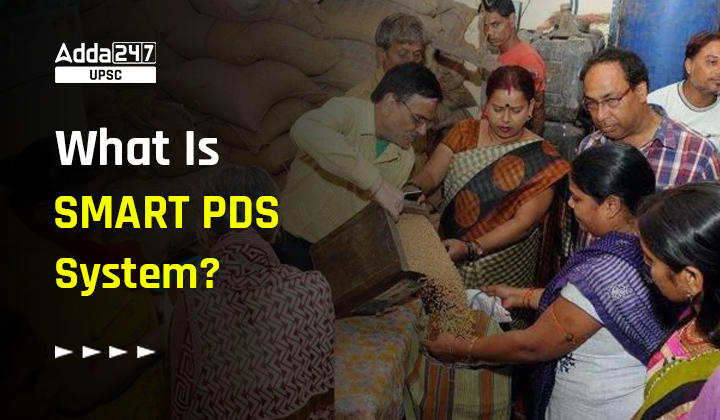Table of Contents
What Is SMART-PDS System?
In This Article, ”What Is SMART-PDS System?”, We Will Discuss: What Is SMART-PDS System?, Objective Of The SMART-PDS System, How PDS Is Operated?, History of Public Distribution System(PDS), etc.
SMART-PDS Context?
In News?
Recently, Food and Commerce Minister Piyush Goyal asked the states to make earnest efforts to implement SMART-PDS at the earliest as SMART-PDS is a technological driven initiative and the need of hour.
Full Form Of SMART-PDS?
Full Form Of SMART-PDS Is ”Scheme for Modernization and Reforms through Technology in Public Distribution System.”
What Is SMART-PDS System?
- What Is The Plan? The Department of Food and Public Distribution(DFPD) is envisaging a new and unified scheme to strengthen the PDS technology components by standardization of its operation and implementation of data driven decision making through the data analytics. This scheme aims to transform the entire PDS IT ecosystem by leveraging the usage of Cloud and new age technology which shall be named as Scheme for Modernization and Reforms through Technology in Public Distribution System -SMART-PDS.
- Smart Ration Card: SMART-PDS is a system where smart ration cards are issued to beneficiaries of public distribution system, and ration is given through fair price shops on production of the smart ration card by any member of the beneficiary family.
- Fingerprint Template: The fingerprint template of the beneficiary is recorded in these smart ration cards, which records all transactions.
Objective Of The SMART-PDS System
- Aim: The aim of The SMART-PDS System is to build an automatic and convenient system to protect the interests of the public by countering the malpractices.
- Purpose: The main purpose of the SMART-PDS System is to implement fingerprint matching algorithm for authentication of the user, which in turn reduces the widespread corruption, misuses of cards and to reduce the time complexity of the manual data entries.
- To Deal With The Black Market? The system is used to protect the products of fair price shop in black markets.
How PDS Is Operated?
- Joint Responsibility Of State And Centre: PDS is operated under the joint responsibility of the Central and the State/UT Governments. The Central Government, through Food Corporation of India (FCI), has assumed the responsibility for procurement, storage, transportation and bulk allocation of food grains to the State Governments.
- Operational Responsibility: The operational responsibility including allocation within State, identification of eligible families, issue of Ration Cards and supervision of the functioning of Fair Price Shops (FPSs) etc., rest with the State Governments.
- Commodity Wise Distribution: Under the PDS, presently the commodities namely wheat, rice, sugar and kerosene are being allocated to the States/UTs for distribution. Some States/UTs also distribute additional items of mass consumption through the PDS outlets such as pulses, edible oils, iodized salt, spices, etc.
History of Public Distribution System(PDS)
Public Distribution System in 1960s
- The public distribution of essential commodities was in existence in the country during the inter-war period.
- However, PDS, with its focus on distribution of foodgrains in urban scarcity areas, had emanated from the critical food shortages of 1960s.
- PDS had substantially contributed to the containment of rise in food grains prices and ensured access of food to urban consumers.
- As the national agricultural production had grown in the aftermath of Green Revolution, the outreach of PDS was extended to tribal blocks and areas of high incidence of poverty in the 1970s and 1980s.
Revamped Public Distribution System (RPDS)
- The Revamped Public Distribution System (RPDS) was launched in June, 1992 with a view to strengthen and streamline the PDS as well as to improve its reach in the far-flung, hilly, remote and inaccessible areas where a substantial section of the poor live.
Targeted Public Distribution System (TPDS)
- In June, 1997, the Government of India launched the Targeted Public Distribution System (TPDS) with focus on the poor.
- Under the PDS, States were required to formulate and implement foolproof arrangements for identification of the poor for delivery of foodgrains and for its distribution in a transparent and accountable manner at the FPS level.
Antodaya Anna Yojana (AAY)
In order to make TPDS more focused and targeted towards this category of population, the “Antyodaya Anna Yojana” (AAY) was launched in December, 2000 for one crore poorest of the poor families.
Conclusion
Smart-PDS is a technology driven initiative and is the need of the hour, therefore all the States/UTs should make serious efforts to implement Smart-PDS at the earliest.


 TSPSC Group 1 Question Paper 2024, Downl...
TSPSC Group 1 Question Paper 2024, Downl...
 TSPSC Group 1 Answer key 2024 Out, Downl...
TSPSC Group 1 Answer key 2024 Out, Downl...
 Cabinet Ministers of India 2024, New Cab...
Cabinet Ministers of India 2024, New Cab...







